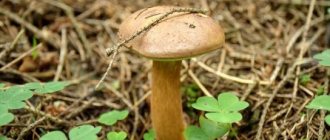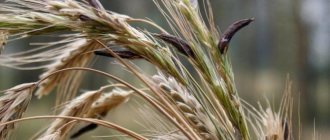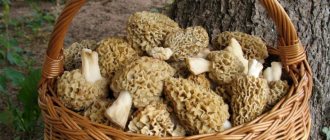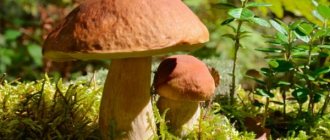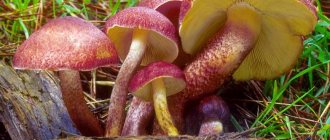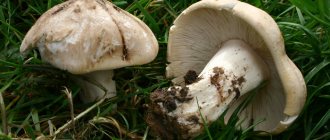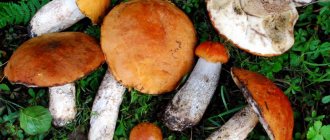Classification of mushrooms (groups)
Classification of mushrooms involves the distribution of mushrooms into departments, classes, orders, families, genera and species that have common characteristics. Taxonomy, as a scientific discipline, develops the principles of classification of living organisms, which are the basis for constructing the system of their taxonomy itself.
The fungal kingdom is divided into 4 groups, which include 36 classes, 140 orders, 560 families, 8,280 genera and 97,860 species of fungi.
Groups of mushrooms
Today all mushrooms are divided into three groups. This classification is based on the morphology of the reproductive part (fruiting bodies) of fungi, which are formed from threads (intertwined hyphae) of the mycelium (mycelium). Fungal groups are distributed in the following order:
- Macromycetes.
- Gasteromycetes.
- Myxomycetes.
The first two groups (macromycetes) unite representatives of the department of higher fungi (they have multicellular mycelium). The group of myxomycetes includes fungus-like organisms (slug molds, yeasts, molds and other microscopic fungi), which at a certain stage of their development have the type of plasmodium (a single-celled parasitic organism) or the type of pseudoplasmodium (a multicellular mass consisting of an accumulation of amoeboid cells).
Macromycetes
Fungi, which make up the group of macromycetes, form large fruiting bodies and rather large accumulations of mycelium. Everyone knows cap mushrooms - chanterelles, oyster mushrooms, russula, saffron milk caps, etc. Some of them are edible, others can cause poisoning in humans and animals, for example, toadstool. Among macromycetes, symbiotrophic and saprophytic fungi are distinguished.
- Symbiotrophic fungi form a fungal root (mycorrhiza). By enveloping small plant roots and root hairs in mycelium, they provide themselves with nutrition, but at the same time release minerals necessary for the plant and process waste (ceps, saffron caps, boletus mushrooms, etc.).
- Saprophytic fungi, together with bacteria, decompose organic dead remains (forest litter) and convert it into nutrients for higher plants. Forest soil saprophytes include talkers, morels, etc., soil saprophytes of open spaces include puffballs, champignons, dung beetles, meadow mushrooms, etc.
Rice. 2. Porcini mushroom and chanterelles are typical representatives of the group of macromycetes.
Gasteromycetes
The group of gasteromycetes includes about 1 thousand species of fungi from 110 genera. They have a closed structure of the fruiting body (angiocarpous), during puberty some of them remain completely closed (endogasteromycetes), others open in different ways (exogasteromycetes). The mycelium of fungi is well developed, it is highly branched, multicellular, and completely penetrates the substrate. The hyphae form long micellar strands. They permeate the entire substrate, often visible even on the surface. Their thickness ranges from a few millimeters to 1 cm or more, and their length reaches several meters. The fruiting bodies of Gasteromycetes are terrestrial (giant puffball, giant bighead), semi-underground and underground (look like tubers). Large-sized mushrooms produce a huge number of spores; they are considered the most prolific organisms. For example, the giant bighead is the same size as a large watermelon and produces about 7.5 trillion spores, the same as 400 champignons. Gasteromycetes are mainly saprophytes. There are soil saprophytes (forest, steppe, semi-desert, desert) and non-soil saprophytes that settle on dead wood, dead wood and rotting plant debris (nest, nidularia, crucibulum, goblet, spherobolus and pear-shaped puffball). The group of gasteromycetes includes a small number of mycorrhizal fungi and lead a parasitic lifestyle. Mushrooms such as common veselka and purple capitol are used in folk medicine.
Rice. 3. Champignons and giant bighead are representatives of the group of gasteromycetes.
Rice. 4. Non-soil saprophytes pear-shaped raincoat (left) and goblet (right).
Myxomycetes
The group of myxomycetes includes fungi and fungus-like organisms that, at a certain stage of their development, have the type of plasmodium (a single-celled parasitic organism) or the type of pseudoplasmodium (a multicellular mass consisting of an accumulation of amoeboid cells). Plasmodium in most types of fungi is clearly visible, it is able to move, sporulation organs are formed from plasmodium or pseudoplasmodium, reminiscent of the fruiting bodies of mushrooms. The myxomycetes group includes more than 800 species of fungi.
Rice. 5. The photo shows slime molds. Stemonitis mushroom (photo on the left). The mucus is chocolate-colored and forms cigar-shaped stems that support the supporting “structure.” In most species, slime molds have a net-like shape (photo on the right).
Elementary.
• It is best to go for mushrooms early in the morning. The most convenient time for picking mushrooms ranges between 6 and 7 am.
• The most favorable weather for the appearance of mushrooms is warm rain with sunshine. That is, if there was a light warm rain in the evening, then in the morning there will probably be a good harvest.
• Under no circumstances should you collect mushrooms near roads, railways, various factories, and especially in cities, since mushrooms tend to absorb all the harmful particles that are in the air.
• Perhaps the most important rule: if you don’t know, don’t take a mushroom. At any slightest suspicion, it is better to simply leave the mushroom in the forest.
• Under no circumstances take mushrooms that have already rotted. Even if the rotten part is removed, the taste and beneficial qualities of the mushroom may suffer.
• Overripe and soft mushrooms, as well as wormy mushrooms, should also not be taken.
• It is best to collect mushrooms in baskets made of willow twigs or birch bark baskets. It is not recommended to put mushrooms in plastic bags and buckets, as they quickly deteriorate due to lack of air exchange.
Classification of mushrooms (divisions, classes)
Currently, mushrooms are divided into 4 kingdoms:
- Real mushrooms (Fungi).
- Pseudofungi (Protozoa).
- Semi-fungi (Protista).
- Protozoa (Chromista).
They occupy an intermediate position between the animal and plant kingdoms. Based on the structure of mushrooms, mycelium and hyphae, methods of reproduction, chemical composition, etc., all mushrooms are divided into classes. This classification includes mushrooms that are of practical importance to humans.
The Kingdom of true mushrooms (Regnum Fungi) includes the following divisions:
- Higher fungi, classes basidomycetes, ascomycetes and endomycetes.
- Imperfect fungi, class Deuteromycetes.
- Lower fungi, classes oomycetes, chytridiomycetes and zygomycetes.
The Kingdom pseudofungi (Regnum Protozoa) includes:
- "Fungi-like organisms".
- The classes are myxogasteromycetes, protosteliomycetes, dictyostelomycetes, acrasiomycetes and plasmodiophoromycetes.
The Kingdom of semi-fungi (Regnum Protista) includes the division “Mushroom-like protozoa” of the class Actinomycetes.
The Kingdom of Protozoa (Regnum Chromista) includes:
- Department "Protozoa".
- Classes Hyphochytriomycetes, Glomeromycetes and Labyrinthulomycetes.
Higher mushrooms are popular among mushroom pickers, restaurateurs and cooks, winemakers and brewers, and are widely used in the pharmaceutical industry. Imperfect mushrooms are used by chemists, food workers, tanners, and pharmacists.
Lower fungus-like organisms are of interest to agricultural workers and mycological scientists.
Rice. 6. The group of myxomycetes includes a huge variety of fungus-like organisms - slime molds.
Mushroom farming.
Although the widely bred field champignon is found in nature in open places, it does not contain green chlorophyll, unlike plants, so it develops normally even in the absence of light. It is often bred in abandoned mines and caves, where it is easy to maintain a constant temperature - one of the most important conditions for the growth of the fruiting body. Proper nutrition and moisture are also necessary. Champignons are also bred in cellars or specially built barns. Amateurs often think that growing mushrooms is as easy as shelling pears, but this activity requires special knowledge and it is very difficult to compete with professionals.
Real mushrooms (Regnum Fungi)
Based on the structure of mushrooms, methods of reproduction, chemical composition and other indicators, all mushrooms are divided into 36 classes, 13 of which are especially significant.
Department of higher mushrooms
Class Basidiomycetes or cap mushrooms
The class of basidiomycetes includes about 30 thousand species of fungi. Fungi of this class have very well developed hyphae (thin branching threads forming mycelium) with partitions; hyphal cells contain 2 nuclei. In a thin layer of fruiting bodies (hymenium), sexual sporulation structures (basidium) and immobile spores (basidiospores) are formed. Different types of mushrooms in this class protect their spores in different ways.
- So, in some, the spores are located inside the fruiting body and are released when its shell (peridium) is destroyed or through a special hole in it. This type of development is called closed (angiocarpous). Observed in raincoats.
- Other types of fungi have a semi-closed development type. The surface of the spore-bearing layer is covered, like a blanket, with a special shell, after the rupture of which the spores are released. This type of development is observed in fly agarics.
- Open type of development (gymnocarpous). Thus, in mushrooms such as laticifers, russula and many others, the part of the fruiting body bearing the spore-bearing layer is not closed.
The forms of basiomycetes are very diverse: spherical (puffballs), branched like corals (horned mushrooms), in cap mushrooms the stem can be located in the center or on the side, or absent altogether (sessile fruiting bodies).
Basidiomycetes are saprophytes. They feed on organic remains of dead bodies or animal excrement. A small part of them live as parasites. A large number of mushrooms of this class are of interest to mushroom pickers.
- Soil saprophytes include champignons, umbrellas, and dung beetles.
- Tree saprophytes include honey mushrooms, mulberries, and scales.
- The group of symbiont fungi (developing in close contact with the root system of woody plants) includes boletus, boletus (ceps), and boletus.
- The group of parasitic fungi includes capitate and rust fungi.
- Some families of fungi (for example, Pucciniaceae) are the most dangerous enemies of the crop. Diseases of flax, damage to poplar leaves and needles of American and Siberian pines are caused by fungi of the Melanosporaceae family.
Rice. 7. In the photo there is a boletus and a fly agaric.
Class Ascomycetes or marsupial fungi
Ascomycetes comprise about 6,400 genera and more than 30 thousand species of fungi. They have very well developed hyphae (thin branching threads that form mycelium), have partitions, and the cells contain one nucleus. The fruiting bodies of ascomycetes have different shapes. They are located at the ends of the hyphae in the form of a bag (ascus). They contain immobile spores. Ascomycetes include molds and fungi that form fruiting bodies - strings, morels and truffles. Ascomycetes are mainly saprophytes. They live on the remains of animals and plants, including higher ones.
Rice. 8. In the photo there is a morel and a truffle.
Class Endomycetes
Endomycetes are considered the most ancient and primitive subgroup of fungi, the source of all ascomycetes. Many consider them to be a class of ascomycetes - marsupial fungi.
The group of endomycetes includes microscopic organisms, both unicellular and multicellular. Single-celled organisms reproduce by budding. Multicellular organisms reproduce vegetatively, that is, new individuals are formed from the body of the parent individual and grow as hyphae. They live both as parasites on higher plants and as saprophytes on plant remains, in soil, in animal droppings and digestive organs.
Rice. 9. Yeast fungi are representatives of endomycetes. During the process of evolution, they lost the ability to form mycelium.
Department of imperfect mushrooms
Imperfect fungi have all the characteristics of basidiomycetes and ascomycetes, except that they reproduce asexually. Basidiomycetes, ascomycetes and deuteromycetes represent the largest subgroup of fungi, comprising up to 30% of all species known today.
Class Deuteromycetes
Deuteromycetes, unlike other classes of fungi, do not have common ancestors. This is a heterogeneous group that includes fungi of the classes of basidiomycetes and ascomycetes, in which sexual reproduction was lost during the process of evolution. The class Deuteromycetes includes about 25,000 species.
In fungi of this class, the hyphae are branched, have partitions, and the cells are multinucleate. Reproduction occurs asexually by immobile spores (conidia), which distinguishes them from basidiomycetes and ascomycetes. In deuteromycetes, the reproductive organs are conidiophores (organs of asexual reproduction), they have the appearance of a powdery coating. Most imperfect fungi are saprophytes. A huge number of them can be found on plant remains, and somewhat less often on animal remains; they actively influence soil formation. Deuteromycetes are used to produce enzymes used in the textile, leather and food industries. I use Aspergillus mushrooms to produce oxalic, citric, fumaric and gluconic acids. Among them, species are known that produce substances used in the production of antibiotics. Imperfect fungi spoil food and cause diseases in plants, animals and humans.
Rice. 10. Aspergillus grows as mold on the surface of many substrates. They use organic substances to ensure their vital functions.
Department of lower mushrooms
The department of lower fungi (unicellular) includes oomycetes, chytridiomycetes, zygomycetes, glomeromycetes, hyphochytriomycetes, labyrinthulomycetes. The type of sexual development (sporation) plays a key role in the division of fungi into classes. Their vegetative body is formed by mycelium and has a cellular structure. Their sexual method of reproduction is less perfect than that of higher fungi. The mycelium is highly branched, unicellular, multinucleate.
Class Oomycetes
The oomycete group includes 7 genera and 570 species. Microscopic oomycete fungi have a fibrous vegetative body, the mycelium is weakly branched, without partitions, the cell wall contains cellulose (in higher fungi, chitin). The reserve substance is glucan and mycolpminarin. The type of reproduction is sexual. The spores are biflagellate.
Oomycetes mainly lead a parasitic lifestyle and only a few of them are saprophytes. They infect various cultivated plants (beets, potatoes, cucumbers, salads, cultivated cereals, grapes, tobacco, cruciferous vegetables), causing late blight and downy mildew, and are the cause of disease in fish and their eggs.
Rice. 11. The photo shows oomycetes.
Rice. 12. Damage to cucumbers and roses by oomycetes (downy mildew).
Rice. 13. Damage to larvae and fish by oomycetes.
Class Chytridiomycetes
Chytridiomycetes are microscopic unicellular fungi with several nuclei; their reproductive cells and spores have a thin cytoplasmic outgrowth (flagellum), with the help of which they move and infect plants. The fruiting body in some chytridiomycetes is a cytoplasmic mass (amoeboid), in others it is a mycelium (mycelium). Fungi of this class reproduce sexually and asexually. Chytridiomycetes live in water bodies and moist soils, parasitizing algae, aquatic fungi and animals. They affect higher plants (black leg of cabbage), cause potato cancer, etc. The class of chytriomycetes includes 120 genera and more than 1000 species.
Rice. 14. The photo shows chytridiomycetes.
Rice. 15. “Black leg of cabbage.”
Class Zygomycetes
The class Zygomycetes includes about 400 species of fungi. Their mycelium is well developed, it is white, multinucleated, abundantly branched. Chitin was found in cell membranes. The spores are motionless. They reproduce both sexually and asexually. The sexual method of reproduction is called “zygomania”. During this process, the fusion of two gametes located at the ends of the hyphae occurs (gamete “+” and gamete “-”). The germ cells of one or two different mycelia unite. The fusion of female and male reproductive cells occurs as a result of the release of “love molecules” - an ester of benzoic acid, under the influence of which cells of different sexes are attracted and a zygote is formed.
Zygomycetes live mainly in soil. They are saprophytes. With their help, humus (humus) is formed. Some of them develop on food products (mold), affect insects (locusts and grasshoppers), higher fungi, invertebrate animals and plants (potatoes, strawberries, wild strawberries, beets, sunflowers, fig and grape vines).
Rice. 16. Molds of the mucor genus (photo on the left) and mold on berries (photo on the right).
Mastigomycotina
(“flagellate fungi”). These are mainly aquatic organisms that form motile flagellated spores (zoospores) during asexual reproduction. Based on the characteristics of zoospores (the number and location of flagella), three classes are distinguished, of which the most famous is the class of oomycetes (Oomycetes). This includes, in particular, the order Saprolegniales, also called “water molds.” They cause economic damage by parasitizing fish and their eggs. These mushrooms often form fringed mycelium visible to the naked eye on dead fish carcasses floating in rivers and lakes. Oomycetes also include pathogens of dangerous plant diseases, included in the genus Pythium
,
Phytophthora
and
Peronospora
.
Pythium
species cause root rot of seedlings and vascular necrosis of shoots in poorly drained soils, often becoming a serious problem in nurseries and greenhouses.
The species Phytophthora infestans
is widely known as the cause of the “potato plague,” which led to the widespread destruction of this crop and caused a terrible famine in Ireland in 1845–1847: it reduced the country’s population by more than 1.5 million people and led to mass migration of its inhabitants to North America.
Species of Peronospora
and related genera are the causative agents of the so-called. downy mildew, causing serious damage to crops of onions, lettuce and a number of other crops.
Pseudofungi (Regnum Protozoa)
The kingdom Protozoa includes the department of mushroom-like organisms (slug molds), which unites more than 450 species of organisms, diverse in structure and lifestyle, widely distributed in nature. The department of fungi-like organisms includes 5 classes of slime molds: myxogasteromycetes, protosteliomycetes, dictyosteliomycetes, acrasiomycetes and plasmodiophoromycetes. They do not form fruiting bodies and reproduce asexually. Of interest to physicians and pharmacologists.
Class Myxogasteromycetes
Plasmodium slime molds belong to this class. Their fruiting body (plasmodium) is protoplasm, devoid of a shell, multinucleated, biflagellate spores. Plasmodium can be unicellular or multicellular (pseudoplasmodium). The type of movement is amoeboid. Sporangia develop from plasmodium, which are located in the place (ethalia). In some species, the etalia look like flattened voluminous pads fused into barrels. The walls are thick, bark-like. The spores emerge at the apex of the etalia. In others, the sporangia grow together, in some cases so tightly that it is impossible to distinguish individual sporangia.
Myxogasteromycetes are saprophytes. They live in dark, damp places, on rotten roots, stumps, and fallen leaves. When moving, they move towards darkness and dampness.
Rice. 17. The photo shows Myxogasteromycetes.
Class Protosteliomycetes
In slime molds of this class, the vegetative body has a special shape in the form of an amoeboid. A single-celled organism has a huge number of nuclei (up to 1 million). Amoeboids have different colors - from colorless to black. In most species, slime molds have a net-like shape. Sizes from microscopic to meters. They move actively. During the period of sporulation, the plasmodium is covered with a cartilaginous shell, inside which spores are formed (plasmodiocarp), shaped like a flat cake, sometimes irregular in shape. Saprophytes. Distributed everywhere in all climate zones. They live in dark, damp places, on rotten roots, stumps, fallen leaves and in damp soil. When moving, they move towards darkness and dampness.
Rice. 18. In the photo are simplesteliomycetes.
Class Dictyosteliomycetes
A special class of cellular slime molds. Under normal environmental conditions and the presence of food, they live in the soil in the form of single-celled amoebae, reproduce by division, and feed on bacteria. Under unfavorable conditions, they gather together, forming pseudoplasmodium, which is covered with a thin protective film on top. Inside it, the amoebas do not merge with each other, but the pseudoplasmodium itself is able to move as a single unit. Under favorable conditions, the movement stops and the pseudoplasmodium turns into a fruiting body (sporophore). The sporophore is a head with spores, located on a thin stalk, rising above the fruiting body. Dictyosteliomycetes have no practical significance for the average person.
Rice. 19. Under unfavorable conditions, dictyosteliomycetes gather together, forming pseudoplasmodium, which is covered with a thin protective film on top.
Class Acrasiomycetes
Acrasiomycetes are non-enveloped, single-celled slime molds that have the appearance of an amoeba. They move with the help of a pseudopod (pseudopodia). They reproduce by division. Fungal cells have one centrally located nucleolus. When food supplies are depleted, they come together and form a single mass - a motionless pseudoplasmodium, but the cells do not merge. In some pseudoplasmodiums, a spore-bearing organ (sporocarp) is formed, consisting of a stalk and a head, in others it is branching, forming chains of spores. When released into the soil, the spores first form myxoamoebas (coated spores) and then germinate. Acrasiomycetes live in the soil on rotting organic matter, including manure.
Rice. 20. Acrasiomycetes.
Class Plasmodiophoromycetes
Plasmodiophoromycetes are intracellular parasites of plants; they do not form sporangia; spores develop from plasmodium, and the host cell itself is their container. As a result of this process, plant cells hypertrophy, some of them begin to rapidly divide. Growths of various shapes and sizes form on the roots and tubers of plants.
Fungi attack cruciferous crops, especially those cultivated on acidic soils (mustard, cabbage, radish, rutabaga, radishes, etc., ferns, algae and higher mushrooms).
Rice. 21. Formation of spores of plasmodiophoromycetes inside the host cell (photo on the left) and damage to tubers (photo on the right).
Basidiomycotina
(basidial fungi). A distinctive feature of these fungi is the maturation of sexual spores (basidiospores) on the surface of special structures, the so-called. basidia. Each of the basidia is formed at the end of the hyphae and is a swollen cell (less often four cells) with thin projections (sterigmata), to which the basidiospores are attached.
This subdivision includes many mushrooms with large, fleshy fruiting bodies, including tinder fungi, puffballs, ground stars, vesels, tremblers and cap mushrooms. Most of them are saprotrophs, playing an important role in the decomposition of fallen leaves, dead wood and manure. However, the true house mushroom ( Serpula lacrymans
) causes great damage, causing rotting of wooden buildings, and autumn honey fungus (
Armillaria mellea
) is a dangerous parasite of living trees.
Among the cap mushrooms, there are both edible ones, in particular the white mushroom ( Boletus edulis
) and chanterelle mushroom (
Cantharellus cibarius
), highly valued by gourmets, and extremely poisonous ones, for example, the pale toadstool (
Amanita phalloides
), and hallucinogenic, of which psilocybe is well known in this regard semilanceata (
Psilocybe semilanceata
) and red fly agaric (
Amanita muscaria
).
Based on the characteristics of the development of basidia, it is customary to distinguish three classes of basidiomycetes. The class Hemibasidiomycetes includes rust (Uredinales order) and smut (Ustilaginales order) fungi - plant parasites that cause great economic damage. The first of them probably affected ferns back in the Carboniferous period, i.e. approximately 300 million years ago. The Hymenomycetes class includes lamellar, tubular and tinder fungi. The class Phragmobasidiomycetes includes, in particular, trembling fungi (order Tulasnellales).
Semi-mushrooms (Regnum Protista)
The kingdom of semi-fungi includes the department of mushroom-like protozoa, which is represented by the only class of actinomycetes.
Class Actinomycetes
The word actinomycetes means radiant fungi. Their body is represented by one large branching cell. Vegetative cells of higher forms of actinomycetes are divided by partitions (septa). Next, conidia and sporangia with spores are formed on the conidie-bearing hyphae. Conidia are collected in a bunch. The spores are mobile. Lower forms of actinomycetes reproduce by fragments of mycelium or by its disintegration into separate fractions (oidia). Less commonly, reproduction occurs by budding.
When growing on nutrient media, colonies of some fungi are colorless or whitish, while other fungi form pigments, as a result of which the nutrient medium turns purple, blue, pink, red, green, orange, brown and black.
Actinomycetes are found in different geographical areas, different types of soil and water. Many of them are saprophytes, transforming the organic remains of dead organisms into simple organic compounds.
All actinomycetes are used to produce antibiotics. Streptomycetes produce streptomycin, tetracycline, erythromycin, nystatin, etc. Fungi are producers of organic compounds necessary for humans: amino acids, steroids and enzymes. At the same time, actinomycetes cause severe diseases of agricultural plants, animals and humans: nocardiosis, actinomycosis, tuberculosis, leprosy.
Rice. 22. Mycelium of actinomycetes.
Deuteromycotina.
This group is also called Fungi imperfecti, i.e. “imperfect fungi”, since sexual reproduction and associated structures are unknown in them. The taxonomy of such fungi is based on the method of formation of their asexual spores (conidia). The group is, in principle, artificial; over time, sexual forms are discovered in its individual representatives, and as a result, the same species can be described under different names, for example, as imperfect (asexual, or anamorphic, stage) and as a marsupial (sexual , or teleomorphic stage).
Protozoa (Regnum Chromista)
The Kingdom of Protozoa includes protozoan microorganisms, algae and zoosporic fungi. Zoosporous fungi are represented by hyphomycetes, glomeromycetes and labyrinthulomycetes.
Class Hyphomycetes (Hyphochytriomycetes)
The vegetative body of fungi of the hyphomycete class is a single cell, often without a shell, or a rudimentary mycelium (rhizomycelium). Reproduction is asexual and occurs with the help of zoospores that have one feathery flagellum. The cell membrane contains cellulose and chitin. Hyphomycetes are parasites of marine and freshwater algae, invertebrates and aquatic fungi. Some of them are saprophytes, living on the remains of plants and animals, in soil and water. About 20 species of mushrooms of this class are known.
Rice. 23. Some hyphomycetes are saprophytes.
Mycelium.
Despite all the diversity of fungi, the vast majority of them have a characteristic characteristic specific to this group - mycelium, i.e. a system of threads that absorb nutrients. The threads themselves are called hyphae; each of them is surrounded by a fairly rigid wall of chitin and (or) cellulose in combination with other polysaccharides (carbohydrates similar in molecular structure to starch). Hyphae serve not only for nutrition: they form special reproductive structures - sporophores or “fruiting bodies”, and spores on or inside them. Mycelium is one of the most important distinguishing features of fungi, but yeast and slime molds are an exception: the former are usually unicellular and do not have true hyphae, and the latter are distinguished by the presence of a “crawling” amoeboid stage in the development cycle.
Great Kingdom
Fungi are extremely ancient organisms, whose life on our planet is at least 900 million years old, and incredibly diverse - about 100 thousand of their species are now described, but it is well known that there are at least three times more of them. Scientists - mycologists are constantly discovering and describing new types of forest gifts, but the number of as yet unknown species is still greater than those described and studied, so the Kingdom of Mushrooms is, to a large extent, still unexplored and mysterious territory.
Not easy at all
The science of mushrooms - mycology - is not the most precise of sciences. There are a huge number of very similar species and subspecies of mushrooms, and even scientists are not always able to accurately separate them from each other. Sometimes the difference between one species and another is determined only on the basis of characteristics that can be seen exclusively with an electron microscope. At the everyday level, everything is even more complicated - among the gifts of the forest there are many species - doubles, which may not be related at all, but be very similar to each other. Moreover, one of these doubles can be an excellent edible mushroom, and the second can be a deadly poison. This is why it is so important, when collecting mushrooms, to always know the detailed external characteristics of specific species.
